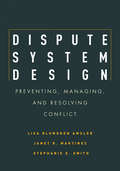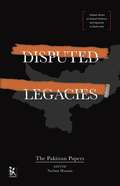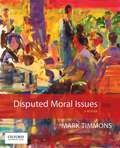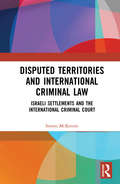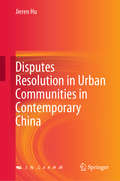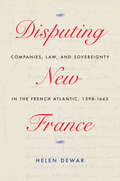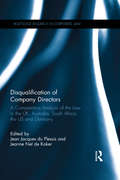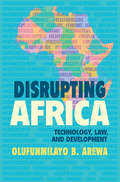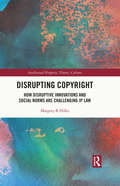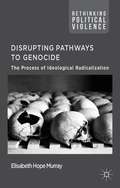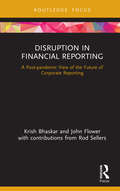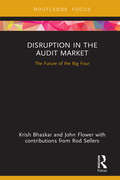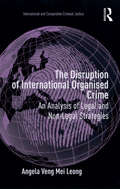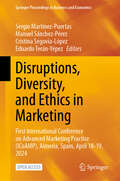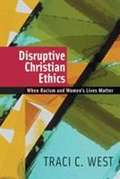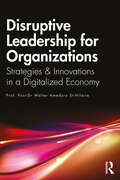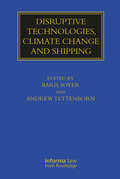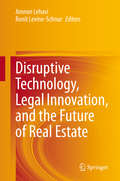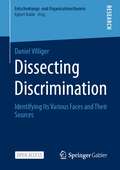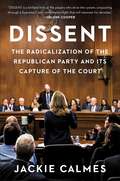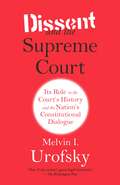- Table View
- List View
Dispute Settlement Reports 2020 Dispute Settlement Reports 2020: Volume 5, Pages 2039 to 2398 (World Trade Organization Dispute Settlement Reports)
by World Trade OrganizationThe Dispute Settlement Reports are the WTO authorized and paginated reports in English. They are an essential addition to the library of all practising and academic trade lawyers and a valued resource for students worldwide taking courses in international economic or trade law. DSR 2019: Volume 5 provides the reports on "Ukraine – Anti-Dumping Measures on Ammonium Nitrate (WT/DS493)" and on "United States – Measures Affecting Trade in Large Civil Aircraft (Second Complaint) (WT/DS353)".
Dispute Settlement Reports 2020: Volume 4, Pages 1523 to 2038 (World Trade Organization Dispute Settlement Reports)
by World Trade OrganizationThe Dispute Settlement Reports are the WTO authorized and paginated reports in English. They are an essential addition to the library of all practising and academic trade lawyers and a valued resource for students worldwide taking courses in international economic or trade law. DSR 2020: Volume 4 provides the reports on 'Australia – Certain Measures Concerning Trademarks, Geographical Indications and Other Plain Packaging Requirements Applicable to Tobacco Products and Packaging (WT/DS435, WT/DS441)'.
Dispute Settlement Reports 2021: Volume 1, 1-401 (World Trade Organization Dispute Settlement Reports)
by World Trade OrganizationThe Dispute Settlement Reports are the WTO authorized and paginated reports in English. They are an essential addition to the library of all practising and academic trade lawyers and a valued resource for students worldwide taking courses in international economic or trade law. DSR 2021: Volume 1 reports on United States - Anti-Dumping and Countervailing Duties on Ripe Olives from Spain (WT/DS577).
Dispute System Design: Preventing, Managing, and Resolving Conflict
by Lisa Blomgren Amsler Janet Martinez Stephanie E. SmithDispute System Design walks readers through the art of successfully designing a system for preventing, managing, and resolving conflicts and legally-framed disputes. Drawing on decades of expertise as instructors and consultants, the authors show how dispute systems design can be used within all types of organizations, including business firms, nonprofit organizations, and international and transnational bodies. This book has two parts: the first teaches readers the foundations of Dispute System Design (DSD), describing bedrock concepts, and case chapters exploring DSD across a range of experiences, including public and community justice, conflict within and beyond organizations, international and comparative systems, and multi-jurisdictional and complex systems. This book is intended for anyone who is interested in the theory or practice of DSD, who uses or wants to understand mediation, arbitration, court trial, or other dispute resolution processes, or who designs or improves existing processes and systems.
Disputed Legacies: The Pakistan Papers (Zubaan Series On Sexual Violence And Impunity In South Asia Ser.)
by Neelam HussainThe Sexual Violence and Impunity in South Asia research project (coordinated by Zubaan and supported by the International Development Research Centre) brings together, for the first time in the region, a vast body of knowledge on this important - yet silenced - subject. Six country volumes (one each on Bangladesh, Nepal, Pakistan, Sri Lanka, and two on India) comprising over fifty research papers and two book-length studies detail the histories of sexual violence and look at the systemic, institutional, societal, individual and community structures that work together to perpetuate impunity for perpetrators. Disputed Legacies focuses on Pakistan, examining law, pedagogy, medical practice and the situations that arise when 'secular' law comes into conflict with traditional practice and belief. The contributors to this volume trace the often-troubled interaction between the state and its women citizens and examine the structures and social systems that enable impunity for perpetrators of sexual violence to gain strength.
Disputed Moral Issues
by Mark TimmonsThe guiding aim of this anthology is to connect various disputed moral issues with moral theory in order to help students better understand the nature of these disputes. The issues featured in this book include questions about the morality of various forms of sexual behavior; pornography, hate speech, and censorship; drugs and addiction; sexism, racism, and reparations; immigration; euthanasia and physician-assisted suicide; the ethical treatment of animals; abortion; cloning and genetic enhancement; the death penalty; war, terrorism, and torture; world hunger and poverty; and ethical questions that relate to consumption, climate change, and the environment in general.
Disputed Territories and International Criminal Law: Israeli Settlements and the International Criminal Court
by Simon McKenzieIt has been over 50 years since the beginning of the Israeli occupation of the Palestinian Territories. It is estimated that there are over 600,000 Israeli settlers living in the West Bank and East Jerusalem, and they are supported, protected, and maintained by the Israeli state. This book discusses whether international criminal law could apply to those responsible for allowing and promoting this growth, and examines what this application would reveal about the operation of international criminal law. It provides a comprehensive analysis of how the Rome Statute of the International Criminal Court could apply to the settlements in the West Bank through a close examination of the potential operation of two relevant Statute crimes: first, the war crime of transfer of population; and second, the war crime of unlawful appropriation of property. It also addresses the threshold question of whether the law of occupation applies to the West Bank, and how the principles of individual criminal responsibility might operate in this context. It explores the relevance and coherence of the legal arguments relied on by Israel in defence of the legality of the settlements and considers how these arguments might apply in the context of the Rome Statute. The work also has wider aims, raising questions about the Rome Statute’s capacity to meet its aim of establishing a coherent and legally effective system of international criminal justice.
Disputes Resolution in Urban Communities in Contemporary China
by Jieren HuThis book explains the causes, process, and results of group disputes in urban communities (the empirical experiences from Shanghai) in China. It explores the means and characteristics of as well as the differences in conflict resolution in various forms of state–society relations, particularly the ways of dealing with and resolving disputes concerning mass incidents involving government interests in China’s current social transformation period. It also analyzes how people’s mediation organizations interact with the local government when managing and defusing collective disputes.Combining the relevant theories and five conflict resolution measurement models created by Blake and Mouton (1964), this book explains the current interaction model and cooperation mechanism between the state and social organizations in China. To do so, it examines the role of the Lin Le People’s Mediation Workroom in dealing with community collective disputes and the respective action strategies and constraints. The book argues that the current state–social relations in China are not centered on society or the state, but on “state-led social pluralism.”
Disputing New France: Companies, Law, and Sovereignty in the French Atlantic, 1598-1663 (McGill-Queen's French Atlantic Worlds Series #7)
by Helen DewarFrom the early sixteenth century, thousands of fishermen-traders from Basque, Breton, and Norman ports crossed the Atlantic each year to engage in fishing, whaling, and fur trading, which they regarded as their customary right. In the seventeenth century these rights were challenged as France sought to establish an imperial presence in North America, granting trading privileges to certain individuals and companies to enforce its territorial and maritime claims. Bitter conflicts ensued, precipitating more than two dozen lawsuits in French courts over powers and privileges in New France.In Disputing New France Helen Dewar demonstrates that empire formation in New France and state formation in France were mutually constitutive. Through its exploration of legal suits among privileged trading companies, independent traders, viceroys, and missionaries, this book foregrounds the integral role of French courts in the historical construction of authority in New France and the fluid nature of legal, political, and commercial authority in France itself. State and empire formation converged in the struggle over sea power: control over New France was a means to consolidate maritime authority at home and supervise major Atlantic trade routes. The colony also became part of international experimentations with the chartered company, an innovative Dutch and English instrument adapted by the French to realize particular strategic, political, and maritime objectives.Tracing the developing tools of governance, privilege granting, and capital formation in New France, Disputing New France offers a novel conception of empire – one that is messy and contingent, responding to pressures from within and without, and deeply rooted in metropolitan affairs.
Disqualification of Company Directors: A Comparative Analysis of the Law in the UK, Australia, South Africa, the US and Germany (Routledge Research in Corporate Law)
by Jean Jacques du Plessis and Jeanne Nel de KokerThis book provides a clear overview of the legal rules relating to directors’ disqualification in Australia, Germany, South Africa, the UK and the US, and to highlight the differences in the disqualification regimes of these jurisdictions. The book seeks to determine whether disqualification on application should be developed further as a corporate law and corporate governance tool to ensure that individuals who have a proven record of posing a particular risk to the business community, shareholders and creditors, are indeed disqualified from being directors. The book is unique as it provides a single source where the disqualification regimes of all these jurisdictions are explored and compared. The book will appeal to scholars of corporate law, regulators and policy-makers. The book will also be of particular interest to senior managers and directors to determine precisely what the laws regarding disqualification of company directors are, and what type of behaviour might expose them to potential disqualification.
Disrupting Africa: Technology, Law, and Development
by Olufunmilayo B. ArewaIn the digital era, many African countries sit at the crossroads of a potential future that will be shaped by digital-era technologies with existing laws and institutions constructed under conditions of colonial and post-colonial authoritarian rule. In Disrupting Africa, Olufunmilayo B. Arewa examines this intersection and shows how it encompasses existing and new zones of contestation based on ethnicity, religion, region, age, and other sources of division. Arewa highlights specific collisions between the old and the new, including in the 2020 #EndSARS protests in Nigeria, which involved young people engaging with varied digital era technologies who provoked a violent response from rulers threatened by the prospect of political change. In this groundbreaking work, Arewa demonstrates how lawmaking and legal processes during and after colonialism continue to frame contexts in which digital technologies are created, implemented, regulated, and used in Africa today.
Disrupting Copyright: How Disruptive Innovations and Social Norms are Challenging IP Law (Intellectual Property, Theory, Culture)
by Margery R HilkoNew innovations are created every day, but today’s business leaders are focused on finding disruptive innovations which are cheaper and lower performing than upmarket technologies. They create new markets, and challenge the status quo of existing technological thinking creating uncertainty both in the future of the innovation and the outcome of the market upheaval. Disruptive innovation is an influential innovation theory in business, but how does it affect the law? Several of these technologies have brought new ways for individuals to deal with copyright works while disrupting existing market expectations, while their ability to spawn social norms has presented challenges for legislation. Considering disruptive innovation as a class, this book examines innovations that have impacted copyright in the past, what lessons can be learned from how the law interacted with them, and how the law can successfully deal with them going forward. Creating comprehensive guidance that can be used when faced with disruptive innovations with the aim of more successful legislation, it considers whether copyright law itself has been disrupted through these innovations. Exploring whether disruptive innovations as a class have unique properties that necessitate action by legislators and whether these properties have the possibility to disrupt the law itself, this book theorises how the law should deal with disruptive innovations in general, going beyond a discussion of the regulation of specific innovations to develop a framework for how law makers should deal with disruptive innovations when faced by one.
Disrupting Pathways to Genocide
by Elisabeth Hope MurrayHow does ideology in some states radicalise to such an extent as to become genocidal? Can the causes of radicalisation be seen as internal or external? Examining the ideological evolution in the Armenian genocide, the Holocaust and during the break up of Yugoslavia, Elisabeth Hope Murray seeks to answer these questions in this comparative work.
Disruption in Financial Reporting: A Post-pandemic View of the Future of Corporate Reporting (Disruptions in Financial Reporting and Auditing #3)
by Krish Bhaskar John FlowerSince the global financial crisis of 2007–8, new laws and regulations have been introduced with the aim of improving the transparency in financial reporting. Despite the dramatically increased flow of information to shareholders and the public, this information flow has not always been meaningful or useful. Often it seems that it is not possible to see the wood for the trees. Financial scalds continue, as Wirecard, NMC Health, Patisserie Valerie, going back to Carillion (and many more) demonstrate. Financial and corporate reporting have never been so fraught with difficulties as companies fail to give guidance about the future in an increasingly uncertain world aided and abetted by the COVID-19 pandemic. This concise book argues that the changes have simply masked an increase in the use of corporate PR, impression management, bullet points, glossy images, and other simulacra which allow poor performance to be masked by misleading information presented in glib boilerplate texts, images, and tables. The tone of the narrative sections in annual reports is often misleading. Drawing on extensive research and interviews with insiders and experts, this book charts what has gone wrong with financial reporting and offers a range of solutions to improve information to both investors and the public. This provides a framework for a new era of forward-looking corporate reporting and guidance based on often conflicting multiple corporate goals. The book also examines and contrasts the latest thinking by the regularity authorities. Providing a compelling exploration of the industry’s failings and present difficulties, and the impact of future disruption, this timely, thought-provoking book will be of great interest to students, researchers, and professionals as well as policy makers in accounting, financial reporting, corporate reporting, financial statement analysis, and governance.
Disruption in the Audit Market: The Future of the Big Four (Disruptions in Financial Reporting and Auditing)
by Krish Bhaskar John FlowerFocussing on the dominance of the Big Four auditing firms – PwC, EY, Deloitte and KPMG – this concise volume provides an authoritative critical assessment of the state and future of the audit market, currently the subject of much debate and the focus of significant government enquiries. Drawing on extensive research and a vast collection of evidence from interviews with insiders, experts and users, it explores the key issues of audit quality, independence, choice and the growing expectation gap. Just as disruptive technologies are overturning other established sectors, this book explores their impact on accounting, financial reporting and auditing. It questions whether the Big Four-dominated audit market is prepared not only for the inevitable disruption of new technologies, but also the challenges of negative public perceptions, cynicism about regulation and demands for greater transparency. In the context of increasing high-profile corporate failures, this book provides a compelling scrutiny of the industry’s failings and present difficulties, and the impact of future disruption. At this crucial time, it will be of great interest to students, researchers and professionals in accounting and auditing, as well as policy makers and regulators.
The Disruption of International Organised Crime: An Analysis of Legal and Non-Legal Strategies (International and Comparative Criminal Justice)
by Angela Veng LeongAnalyzing the structures of transnational organized crime, this book considers whether traditional mechanisms and national jurisdictions can tackle this increasing menace. Highlighting the strengths and weaknesses in the present methods of control, the book discusses the possibilities of developing more effective national and international strategies, the creation of non-legal mechanisms outside the traditional criminal justice system and the implications of 'disruption strategies'. The roles of law enforcement officers, tax investigators, financial intelligence officers, compliance officers, lawyers and accountants - in enforcing both civil and criminal sanctions on organized crime - are also considered.
Disruptions, Diversity, and Ethics in Marketing: First International Conference on Advanced Marketing Practice (ICoAMP), Almeria, Spain, April 18-19, 2024 (Springer Proceedings in Business and Economics)
by Sergio Martínez-Puertas Manuel Sánchez-Pérez Cristina Segovia-López Eduardo Terán-YépezAs the marketing landscape continues to evolve, posing fresh challenges for both academics and practitioners, this book explores contemporary marketing issues, trends, challenges, and opportunities. Featuring papers presented at the first annual International Conference on Advanced Marketing Practice (ICOAMP) held in Almería, Spain in 2024, this open access book covers a broad range of topics focused analytics, measurements, and methodologies in marketing, health, medical and beauty decision-making; the impact of digital technologies on marketing management; marketing education; marketing oriented to operational data stores (ODS); non-profit marketing; marketing ethics (CSR) and social media, and digital marketing practices, among others. These topics are centered around three pivotal and interrelated themes: disruptions, diversity, and ethics, which are the cornerstones that drive our collective pursuit of understanding their impact on the world of marketing. It is imperative for modern businesses and marketers alike to grasp the intricacies of these factors and their implications. This book provides valuable contributions for marketing researchers and practitioners as well as managers of businesses in a wide range of industries
Disruptive Christian Ethics: When Racism and Women's Lives Matter
by Traci C. WestThis book brings to the fore the difficult realities of racism and the sexual violation of women. Traci West argues for a liberative method of Christian social ethics in which the discussion begins not with generic philosophical concepts but in the concrete realities of the lives of the socially and economically marginalized.
Disruptive Leadership for Organizations: Strategies & Innovations in a Digitalized Economy
by Walter Amedzro St-HilaireAimed as much at the neophyte as at the insider who questions why intellectual property rights (IPRs) matter in the digital age and the corporate strategies in the digitalised economy, this book approaches with perspicacity the development of disruptive mechanisms for organisations and IPR-centric leadership. The book is focused on organisations and a management systems perspective. The book identifies the technical practices and proposes multi-level strategies to promote disruptive leadership and encourage growth. The book then addresses the fundamentals of innovation and technology governance, from the production of ideas to the distribution of innovative products or services, including prototyping, financing, industrialisation and so on. It presents recent challenges, including open innovation, creativity and design thinking, and innovation of business models, placing them in the context of knowledge and the collaborative economy. The ambition of the book is to propose a framework for thought and action to the manager, which is composed of five walls – organisational creativity, intellectual property, financing, manufacturing and design of innovation – brought together under one roof, the business model of the technology. This device in which the manager must fit is situated in the strategy of his company and is to be embedded in a specific macroeconomic space.
Disruptive Technologies, Climate Change and Shipping (Maritime and Transport Law Library)
by Simon Baughen Andrew Tettenborn Bariş SoyerThis book analyses the impact of two vital and contemporary developments on shipping law and practice: disruptive technologies and climate change. It considers the impact of these new technologies, honing in on likely emerging issues and unresolved questions, especially about existing and potential private law liabilities and concentrates, from the point of view of English, EU and international law, on the legal implications of climate change and associated environmental risks in the shipping sector. Written by a contributor team drawn from the most experienced and knowledgeable academics and practitioners in shipping law, this treatment of these growing areas of practice will be of great use to lawyers and administrators across the world.
Disruptive Technology, Legal Innovation, and the Future of Real Estate
by Amnon Lehavi Ronit Levine-SchnurThis book addresses challenges that new technologies and the big data revolution pose to existing regulatory and legal frameworks. The volume discusses issues such as blockchain and its implications for property transactions and taxes, three (or four) dimensional title registration, land use and urban planning in the age of big data, and the future of property rights in light of these changes. The book brings together an interdisciplinary collection of chapters that revolve around the potential influence of disruptive technologies on existing legal norms and the future development of real estate markets. The book is divided into five parts. Part I presents a survey of the current available research on blockchain and real estate. Part II provides a background on property law for the volume, grounding it in fundamental theory. Part III discusses the changing landscapes of property rights while Part IV debates the potential effects of blockchain on land registration. Finally the book concludes with Part V, which is devoted to new technological applications relevant to real estate. Providing an interdisciplinary perspective on emerging technologies that have the potential to disrupt the real estate industry and the regulation of it, this book will appeal to a broad audience, consisting of scholars, policy-makers, practitioners, and students, interested in real estate, law, economics, blockchain, and technology policy.
Dissecting Discrimination: Identifying Its Various Faces and Their Sources (Entscheidungs- und Organisationstheorie)
by Daniel VilligerThis Open-Access-book examines the phenomenon of discrimination using a descriptive approach. Discrimination is omnipresent, whether it is people who discriminate against other people or, more recently, also machines that discriminate against people. The first part of the analysis employs decision theory on discrimination, leading to two fundamental subtypes: taste-based discrimination and statistical discrimination. The second part links taste-based discrimination to social identity theory, demonstrates that not all taste-based discrimination is ultimately statistical discrimination, and reveals the evolutionary origins of our tastes. The third part surveys how people get their beliefs for statistical discrimination and thereby shows that they often deviate from Bayesianism: they have inherent prior beliefs and do not exclusively update their beliefs according to Bayes’ law. Additionally, the analysis of belief formation highlights the importance of the learning environment. The last part reassembles the previously dissected aspects of discrimination, presents a new descriptive model of discrimination, and lists five implications for a normative theory of discrimination.
Dissent: The Radicalization of the Republican Party and Its Capture of the Court
by Jackie CalmesFeaturing new interviews with his accusers and overlooked evidence of his deceptions, a deeply reported account of the life and confirmation of Brett Kavanaugh, set against the conservative movement's capture of the courts.In DISSENT, award-winning investigative journalist Jackie Calmes brings readers closer to the truth of who Supreme Court Justice Brett Kavanaugh is, where he came from, and how he and the Republican party at large managed to secure one of the highest seats of power in the land.Kavanaugh's rise to the justice who solidified conservative control of the supreme court is a story of personal achievement, but also a larger, political tale: of the Republican Party's movement over four decades toward the far right, and its parallel campaign to dominate the government's judicial branch as well as the other two.And Kavanaugh uniquely personifies this history. Fourteen years before reaching the Supreme Court, during a three-year fight for a seat on the D.C. Circuit Court of Appeals, Democratic Senator Dick Durbin would say to Kavanaugh, "It seems that you are the Zelig or Forrest Gump of Republican politics. You show up at every scene of the crime."Featuring revelatory new reporting and exclusive interviews, DISSENT is a harrowing look into the highest echelons of political power in the United States, and a captivating survey of the people who will do anything to have it.
Dissent and the Supreme Court
by Melvin I. UrofskyFrom the admired judicial authority, author of Louis D. Brandeis ("Remarkable"--Anthony Lewis, The New York Review of Books; "Monumental"--Alan M. Dershowitz, The New York Times Book Review), Division and Discord, and Supreme Decisions--Melvin Urofsky's major new book looks at the role of dissent in the Supreme Court and the meaning of the Constitution through the greatest and longest lasting public-policy debate in the country's history, among members of the Supreme Court, between the Court and the other branches of government, and between the Court and the people of the United States. Urofsky writes of the necessity of constitutional dialogue as one of the ways in which we as a people reinvent and reinvigorate our democratic society. In Dissent and the Supreme Court, he explores the great dissents throughout the Court's 225-year history. He discusses in detail the role the Supreme Court has played in helping to define what the Constitution means, how the Court's majority opinions have not always been right, and how the dissenters, by positing alternative interpretations, have initiated a critical dialogue about what a particular decision should mean. This dialogue is sometimes resolved quickly; other times it may take decades before the Court adjusts its position. Louis Brandeis's dissenting opinion about wiretapping became the position of the Court four decades after it was written. The Court took six decades to adopt the dissenting opinion of the first Justice John Harlan in Plessy v. Ferguson (1896)--that segregation on the basis of race violated the Constitution--in Brown v. Board of Education (1954). Urofsky shows that the practice of dissent grew slowly but steadily and that in the nineteenth century dissents became more frequent. In the (in)famous case of Dred Scott v. Sanford (1857), Chief Justice Roger Taney's opinion upheld slavery, declaring that blacks could never be citizens. The justice received intense condemnations from several of his colleagues, but it took a civil war and three constitutional amendments before the dissenting view prevailed and Dred Scott was overturned. Urofsky looks as well at the many aspects of American constitutional life that were affected by the Earl Warren Court--free speech, race, judicial appointment, and rights of the accused--and shows how few of these decisions were unanimous, and how the dissents in the earlier cases molded the results of later decisions; how with Roe v. Wade--the Dred Scott of the modern era--dissent fashioned subsequent decisions, and how, in the Court, a dialogue that began with the dissents in Roe has shaped every decision since. Urofsky writes of the rise of conservatism and discusses how the resulting appointments of more conservative jurists to the bench put the last of the Warren liberals--William Brennan and Thurgood Marshall--in increasingly beleaguered positions, and in the minority. He discusses the present age of incivility, in which reasoned dialogue seems less and less possible. Yet within the Marble Palace, the members of the Supreme Court continue to hear arguments, vote, and draft majority opinions, while the minority continues to "respectfully dissent." The Framers understood that if a constitution doesn't grow and adapt, it atrophies and dies, and if it does, so does the democratic society it has supported. Dissent--on the Court and off, Urofsky argues--has been a crucial ingredient in keeping the Constitution alive and must continue to be so.(With black-and-white illustrations throughout.)From the Hardcover edition.
Dissent and the Supreme Court: Its Role in the Court's History and the Nation's Constitutional Dialogue
by Melvin I. UrofskyFrom the admired judicial authority, author of Louis D. Brandeis (“Remarkable”—Anthony Lewis, The New York Review of Books; “Monumental”—Alan M. Dershowitz, The New York Times Book Review), Division and Discord, and Supreme Decisions—Melvin Urofsky’s major new book looks at the role of dissent in the Supreme Court and the meaning of the Constitution through the greatest and longest lasting public-policy debate in the country’s history, among members of the Supreme Court, between the Court and the other branches of government, and between the Court and the people of the United States. Urofsky writes of the necessity of constitutional dialogue as one of the ways in which we as a people reinvent and reinvigorate our democratic society. In Dissent and the Supreme Court, he explores the great dissents throughout the Court’s 225-year history. He discusses in detail the role the Supreme Court has played in helping to define what the Constitution means, how the Court’s majority opinions have not always been right, and how the dissenters, by positing alternative interpretations, have initiated a critical dialogue about what a particular decision should mean. This dialogue is sometimes resolved quickly; other times it may take decades before the Court adjusts its position. Louis Brandeis’s dissenting opinion about wiretapping became the position of the Court four decades after it was written. The Court took six decades to adopt the dissenting opinion of the first Justice John Harlan in Plessy v. Ferguson (1896)—that segregation on the basis of race violated the Constitution—in Brown v. Board of Education (1954). Urofsky shows that the practice of dissent grew slowly but steadily and that in the nineteenth century dissents became more frequent. In the (in)famous case of Dred Scott v. Sanford (1857), Chief Justice Roger Taney’s opinion upheld slavery, declaring that blacks could never be citizens. The justice received intense condemnations from several of his colleagues, but it took a civil war and three constitutional amendments before the dissenting view prevailed and Dred Scott was overturned. Urofsky looks as well at the many aspects of American constitutional life that were affected by the Earl Warren Court—free speech, race, judicial appointment, and rights of the accused—and shows how few of these decisions were unanimous, and how the dissents in the earlier cases molded the results of later decisions; how with Roe v. Wade—the Dred Scott of the modern era—dissent fashioned subsequent decisions, and how, in the Court, a dialogue that began with the dissents in Roe has shaped every decision since. Urofsky writes of the rise of conservatism and discusses how the resulting appointments of more conservative jurists to the bench put the last of the Warren liberals—William Brennan and Thurgood Marshall—in increasingly beleaguered positions, and in the minority. He discusses the present age of incivility, in which reasoned dialogue seems less and less possible. Yet within the Marble Palace, the members of the Supreme Court continue to hear arguments, vote, and draft majority opinions, while the minority continues to “respectfully dissent.” The Framers understood that if a constitution doesn’t grow and adapt, it atrophies and dies, and if it does, so does the democratic society it has supported. Dissent—on the Court and off, Urofsky argues—has been a crucial ingredient in keeping the Constitution alive and must continue to be so.(With black-and-white illustrations throughout.)From the Hardcover edition.

